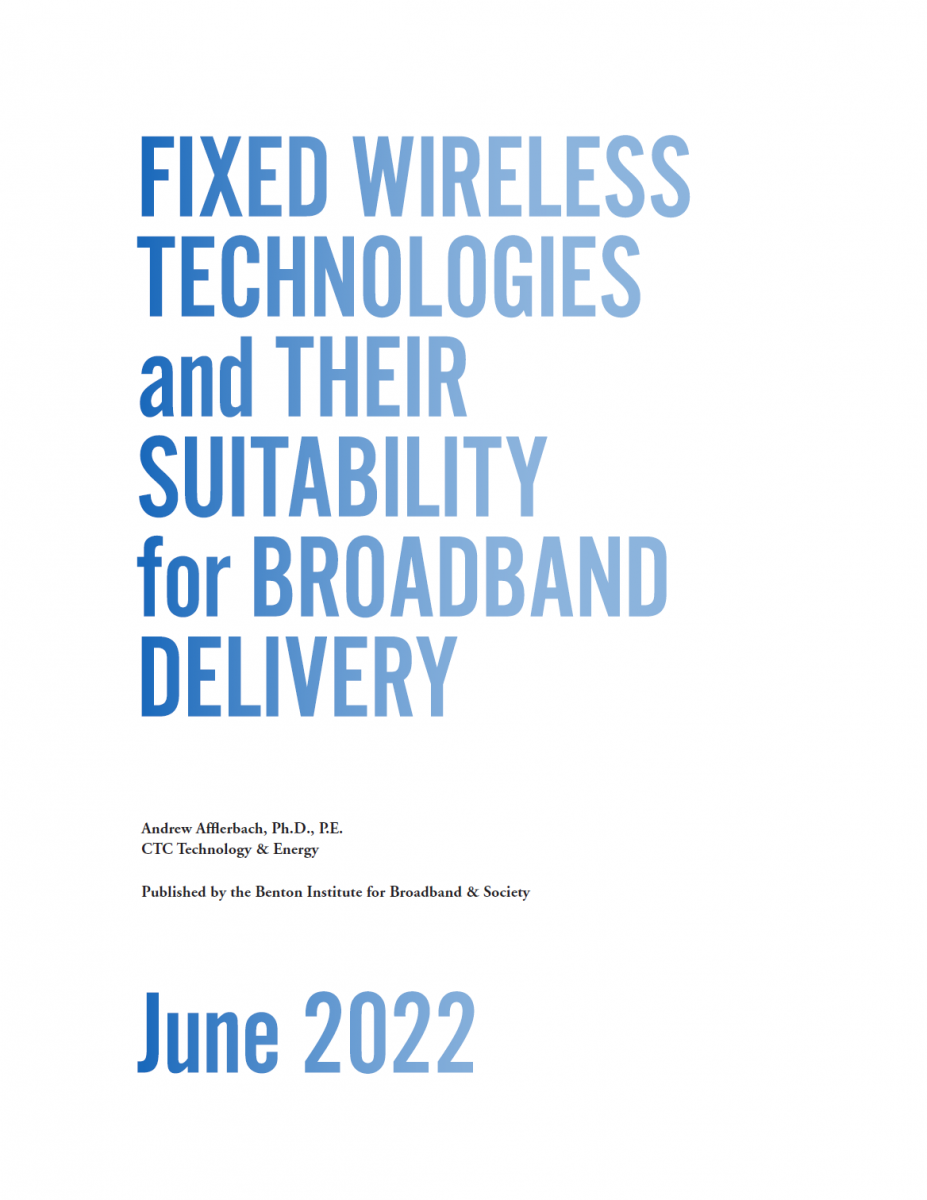How Fixed-Wireless Technologies Compare to Fiber
Friday, June 24, 2022
Weekly Digest
How Fixed-Wireless Technologies Compare to Fiber
You’re reading the Benton Institute for Broadband & Society’s Weekly Digest, a recap of the biggest (or most overlooked) broadband stories of the week. The digest is delivered via e-mail each Friday.
This week's guest writer is CTC Technology & Energy's Andrew Afflerbach, the author of Fixed Wireless Technologies and Their Suitability for Broadband Delivery
Round-Up for the Week of June 20-24, 2022

As state and local governments and their partners plan to invest billions of dollars in federal funding to build broadband infrastructure, choosing the best technology will have significant long-term implications. Federal policymakers have addressed this subject to some degree: For example, the Broadband Equity, Access, and Deployment (BEAD) Program’s notice of funding opportunity (NOFO) preferences fiber over fixed wireless.
To aid state and local policymakers, CTC Technology & Energy conducted an engineering analysis of fixed-wireless technologies and their suitability for delivering broadband service in various environments. The resulting report, Fixed Wireless Technologies and Their Suitability for Broadband Delivery, addresses a range of critical technology and cost considerations related to fixed-wireless networks—and, as a point of comparison, to fiber-to-the-premises networks. The report seeks to do the following:
- Provide an accessible guide to current and anticipated future fixed wireless technologies,
- Demonstrate whether fixed wireless can be a viable approach to delivering broadband to currently unserved residents in various deployment scenarios, such as in urban and rural communities, and
- Suggest how and in what circumstances states should consider using public funds on fixed wireless technologies as a long-term solution to address residential broadband needs.
At a high level, the report concludes the following:
- Fixed-wireless technologies will continue to improve but will not match the performance of fiber-optic networks—primarily because the existing and potential bandwidth of fiber is thousands of times higher than wireless. Also, fixed-wireless networks have inherent capacity limitations that sharply limit the number of users on a network using a given amount of spectrum.
- Fixed-wireless network coverage is adversely affected by line-of-sight obstructions (including buildings and seasonal foliage) and weather. While a fiber network can physically connect every household in a service area (and deliver predictable performance), it is significantly more complex for a fixed-wireless network to deliver a line of sight to every household in a service area.
- Scalability is a critical challenge to fixed-wireless deployments, both technically and financially. A given amount of wireless spectrum is capable of supporting a given amount of network capacity. If the number of network users increases or users need more bandwidth, the network operator must increase the spectrum (which is both scarce and extremely expensive—and may not be possible), upgrade the technology, or add antennas. It is challenging to design a fixed wireless network that will provide sufficient, robust upstream and downstream capacity and reach all the addresses in unserved areas.
- The fastest fixed-wireless technologies (such as those that use millimeter-wave spectrum) are effective in delivering short-range service to closely grouped households in urban and suburban settings. These technologies are largely unsuitable for serving rural communities because of the typical geographic dispersion of addresses and the lack of mounting structures (such as towers or building rooftops).
- Fiber is sustainable, scalable, and renewable. It offers greater capacity, predictable performance, lower maintenance costs, and a longer technological lifetime than fixed-wireless technologies. Fiber service is not degraded by line-of-sight issues and is not affected by the capacity issues that constrain fixed wireless networks.
To further illustrate the relative strengths and weaknesses of fixed-wireless technologies, this report presents an analysis of capital and operating costs for a candidate fixed wireless network as compared to a candidate fiber-optic network in the same real-world settings. The candidate networks were each designed to deliver complete coverage to unserved residential locations.
While the cost analysis illustrates that fiber’s upfront capital costs are higher than those of fixed wireless in many circumstances, the total cost of ownership over 30 years is comparable for fiber and fixed wireless.
The analysis of fixed wireless and fiber-to-the-premises network designs across four types of rural deployment scenarios identified the following key cost factors:
- Initial capital costs are higher for fiber than for fixed wireless network deployments; most of the capital cost for fiber relates to construction.
- Capital costs for fixed wireless deployments are dominated by the cost of customer premises equipment. Another large cost is construction of tower sites (where towers and buildings are not already available for antenna siting).
- Ongoing operational costs for fixed wireless are higher than for fiber—due largely to the need to regularly replace fixed wireless equipment. For a fixed wireless network, 40 to 80 percent of the capital investment needs to be replaced every five years. Only 1 to 10 percent of the capital cost of a fiber network is replaced every 10 years. (Assuming a 50-year lifetime of fiber plant.) Financial sustainability of a fiber network is thus driven mostly by the network’s upfront capital costs; in contrast, financial sustainability of a fixed wireless network that keeps up with the broadband needs of the households depends on the operator’s ability to re-invest every five years.
Given the above analysis, fiber offers the greater long-term value as compared to fixed-wireless technologies because of fiber’s long life, capabilities, scalability, and flexibility. In the event that a state funds technologies other than fiber, such as in circumstances where the capital cost to build fiber is cost-prohibitive or the need for service cannot wait for fiber construction, the state should take steps to protect its investment—such as by requiring grantees to guarantee the long-term maintenance and operations of the fixed wireless network. This could be accomplished by requiring a 20-year performance and budget roadmap, and a viable strategy for full service where line-of-sight is a challenge.
Fixed Wireless Technologies and Their Suitability for Broadband Delivery was commissioned by the Communications Workers of America, prepared by CTC Technology & Energy, and published by the Benton Institute for Broadband & Society.
Andrew Afflerbach, Ph.D., P.E., is CEO and CTO of CTC Technology & Energy. He specializes in planning, designing, and overseeing the implementation of broadband communications networks. Over the course of more than 25 years in the field, Andrew has developed broadband engineering strategy and specifications for dozens of fiber and wireless networks in both rural and urban areas, ranging in size from small towns to large states to nation-wide efforts like the New Zealand fiber-to-the-premises initiative.
Quick Bits
- FCC Announces Tentative Agenda for July Open Meeting
- Biden Administration Awards Nearly $7.7M Additional Grants to Tribal Groups Seeking to Develop Community Broadband Plans (NTIA)
- Here Comes Fixed-Wireless Access (Doug Dawson)
- More Californians are gaining broadband internet access, but Black and Latino households still lag (LA Times)
- US Ignite says cities need all the help they can get navigating broadband funding (Fierce)
Weekend Reads (resist tl;dr)
- LTD Broadband Promised Fast Internet. Rural America Waits…and Waits (WSJ)
- Texas Releases its initial 2022 Broadband Plan (Texas Broadband Development Office)
- New York State Releases Statewide Address-Level Broadband Map (New York Office of Governor)
- The tribal digital divide: Extent and Explanations (Telecommunications Policy)
- Broadband Competition is Thriving Across America (ACA Connects)
ICYMI from Benton
- Helping communities prepare for broadband opportunity (Bill Coleman)
- Where Does the Affordable Connectivity Program Go from Here to Help Millions More Households Get Online? (Jonathan Walter)
- Consumer Protections in the Affordable Connectivity Program (Talia Rothstein)
- The Affordable Connectivity Program Helps to Level the Playing Field for Low Income Households (Joycelyn Tate)
Upcoming Events
Jun 28—How 5G Can Spur Climate Tech Innovation (Information Technology & Innovation Foundation)
Jun 28—Overview of IIJA NOFOs: BEAD, DEA and Middle Mile Programs Webinar (Merit)
Jun 28—Baltimore’s Broadband Movement: A Virtual Event with Community Leadership (Next Century Cities)
Jun 28—Disability Advisory Committee Meeting (FCC)
Jun 28—Connections: How Broadband Investment Influences the U.S. Economy (Network:On)
Jun 29—What Will Be the Impact of the UK’s Online Safety Bill on Encryption and Anonymity Online? (Center for Data Innovation)
Jun 29—Webinar on Using the Broadband Data Collection System (FCC)
Jul 14—July 2022 Open Federal Communications Commission Meeting (FCC)
The Benton Institute for Broadband & Society is a non-profit organization dedicated to ensuring that all people in the U.S. have access to competitive, High-Performance Broadband regardless of where they live or who they are. We believe communication policy - rooted in the values of access, equity, and diversity - has the power to deliver new opportunities and strengthen communities.
© Benton Institute for Broadband & Society 2022. Redistribution of this email publication - both internally and externally - is encouraged if it includes this copyright statement.
For subscribe/unsubscribe info, please email headlinesATbentonDOTorg







